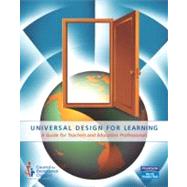Universal Design for Learning

Universal Design for Learning
- ISBN 13:
9780131701601
- ISBN 10:
0131701606
- Edition: 1st
- Format: Paperback
- Copyright: 01/06/2005
- Publisher: Pearson
List Price $46.65 Save
| TERM | PRICE | DUE |
|---|---|---|



List Price $46.65 Save $37.41
In Stock Usually Ships in 24 Hours.
We Buy This Book Back!
Free Shipping On Every Order
List Price $46.65 Save $0.46
Usually Ships in 2-3 Business Days
We Buy This Book Back!
Free Shipping On Every Order
Note: Supplemental materials are not guaranteed with Rental or Used book purchases.
Extend or Purchase Your Rental at Any Time
Need to keep your rental past your due date? At any time before your due date you can extend or purchase your rental through your account.
Summary
Universal Design for Learning: A Guide for Teachers and Education Professionals is written for instructors in education classes as a means of informing current and future teachers about the basics of universal design for learning (UDL) and the ways it can be implemented in schools and classrooms.
The goal of this publication is to inform teachers of the basis for effective teaching practice and to remind them of the various instructional resources available for them to create a UDL environment in their own classrooms. It is worth noting an informed, dedicated teacher is the most essential factor in the success of UDL or any reform. Without a good teacher, the best methods and materials are, at best, ineffective.
Each chapter presents key questions and a scenario of the issues confronting educators for integrating universal design for learning concepts and strategies into the curriculum. After the Introduction, Chapter 1, "Universal Design for Learning in Today's Diverse Schools," discusses how to think about curriculum design and instruction by exploring the links among UDL, assistive technology (AT) , and effective teaching. Chapter 2, "Federal Legislation Supporting Universal Design for Learning and Assistive Technology," offers a brief history and review of the legal and ethical issues surrounding universal design for learning. Chapter 3, "Instructional Theories Supporting Universal Design for Learning: Teaching to Individual Learners," discusses instructional theories that are fundamental to UDL. Chapter 4, "Assistive Technology and Universal Design for Learning in Content Areas," provides available resources and technologies to successfully integrate AT into a UDL environment. Chapter 5, "Collaborative Strategies for Universal Design for Learning Success," provides information on how to collaborate for success in a UDL environment. Throughout the guide, references and resources on professional growth for preservice and inservice teachers, as well as useful Web sites, are available on these topics.
The information in this text is intended to serve as a guide introducing the concept of universal design for learning to educators preparing to teach and those currently instructing students with disabilities. While the chapters are closely linked, instructors will find that several chapters can be used as stand-alone instructional units. These materials were designed specifically for use with general and special education courses on curriculum and methods, technology, and assistive technology. These materials are intended to supplement, not to supplant, regular course materials. To best facilitate understanding of how UDL relates to instructional components described in this text, instructors and learners should actively read with the intent of understanding:
- how UDL combined with instructional and assistive technologies and different learning theories can improve classroom instruction and student outcomes, and
- how curriculum/ instruction would differ if UDL were embedded into materials, expectations, and classroom lessons.
The bulk of the text that follows has been drawn from current research and print-based resources, for two reasons: to demonstrate the extent of readily available information on universal design for learning and to provide an easy means for interested students and educators to access additional information. This book pulls from the research, theory, and practice of individuals who are leading efforts around UDL concepts and AT and instructional technology (IT) strategies. These groups include the Center for Applied Special Technologies (CAST), the Center for Universal Design, the National Center for Accessing the General Education Curriculum (NCAC), the Center for Technology in Education (CTE) at Johns Hopkins University, the Council for Exceptional Children (CEC), and the American Institutes for Research (AIR).
This material was designed primarily as an instructional aid for all teachers who instruct and support students with disabilities. It is also useful, however, to current general education teachers who wish to incorporate UDL methods into their classroom practice, as well as those administrators and others who may be generally interested in the concept of universal design for learning. Universal design for learning integrates different instructional and educational theories with assistive and instructional technology strategies in classrooms. With such a broad base, this guide does not attempt to prescribe one set way of teaching or using a particular product or environment. Rather, it attempts to highlight, organize, and add to existing published literature and resources of UDL.






